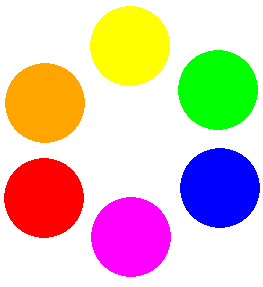- Created By ferret-x
Color Theory
Because my brain won't let me get more advanced without starting off with the basics.
Color Theory. Basically all those technical rules about how colors interact.personally tend to only really think about it if I'm having trouble selecting colors.
First we have the most basic of it. The color wheel.

You probably have seen it before in places such as the wall in your kindergarten class.
The primary colors are red, yellow and blue. They are the three colors that all colors can be mixed from.
The secondary colors are green, orange, and violet. You get them by mixing the colors they're between.
The tertiary colors (not shown) are blue-green, red-orange, yellow-orange, yellow-green, blue-violet, and red-violet.
Complementary or opposite colors are those on opposite sides of the color wheel. The pairs are green-red, blue-orange, and violet-yellow. You get told a lot that those colors go good together, but it seems like those are the colors that will clash the most horribly if you give them a chance as well.
Saturation is how much black or white is in it. The more saturated the "purer" the color. In that color wheel all the colors are the "pure" hex codes (hex codes are the set of numbers and letters that identify every color a computer screen can produce) of the color. Generally you want every object the same distance from the camera to be the same level of saturation (excluding shading dur) Being less saturated show it's farther away from the camera.
Cool colors are blue and most shades of green and violet. They draw the eye less and work better for shading and background colors.
Warm colors are red, orange, and yellow. They draw the eye and are best for the foreground and highlights.
You'll hear all these fancy rules about which colors go together and which don't...but the rules for colors that go together are...
Colors opposite of each other on the color wheel
Colors that are next to each other on the wheel
Colors that are warm go together
Colors that are cool go together
Colors that are the same level of saturation go together
Colors in the same family (like all the shades/hues/tints of blue go together.
An observant person notes this includes every single freaking color ._. So...yeah.
Other colors-
Browns are warm colors with black added
Pinks are really red red-violets or red with white
True indigo does not show up on computer monitors
Black is either all the colors mixed together (pigment) or the absence of color (light)
White is either the absence of color (pigment) or all the colors mixed together (light)
I hope that wasn't too confusing and dull...
The point of this
Well first of all I Ferret like to color (and shade). Not just in one medium like so many people tend to, but in every medium I can find. I wouldn't call myself the best by any means, but I'm certainly not bad ^.^ So in here I guess I'll include tutorials, explanations, and to my experience the use of different brands of certain materials. This is aimed to be a helpful and informative guide so I hope it is found useful.
End